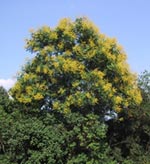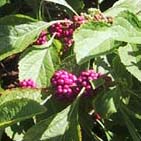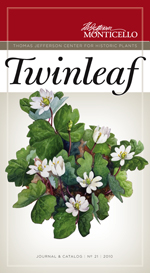"Altho' the times are big with political events, yet I shall say nothing on that or any subject but the innocent ones of botany & friendship." -- Jefferson to Madame de Tessé, October 31, 1803
In August 2001 a letter from Italy arrived at CHP headquarters. The correspondent, a 1998 fellow at Monticello's International Center for Jefferson Studies, wrote to thank us for the gift of a Goldenrain tree (Koelreuteria paniculata), which he had planted in his European garden. Obviously writing as the summer-flowering tree blossomed, the former ICJS fellow reported that "it has grown by now to about 6 feet and gives me continuous pleasure: I call it my Jefferson Tree."
 I was immediately struck by the similarity in sentiment of this 21st-century letter compared to one Thomas Jefferson wrote to Madame de Tessé March 27th, 1811:
I was immediately struck by the similarity in sentiment of this 21st-century letter compared to one Thomas Jefferson wrote to Madame de Tessé March 27th, 1811:
"Since I had last the pleasure of writing to you, I have to acknowledge the receipt of . the seeds of the . Koelreuteria, one of which has germinated, and is now growing. I cherish it with particular attentions, as it daily reminds me of the friendship with which you have honored me ."
This "cherished" tree is native to China, where it was once planted at the graves of high governmental ministers. The first seeds to arrive in Europe were sent during the mid eighteenth century by Pierre Nicholas le Chévron d'Incarville, a French Jesuit Father stationed at a Peking missionary. According to Stephen A. Spongberg in A Reunion of Trees (Harvard University Press, 1990), a Russian caravan likely transported these seeds across Mongolia and Siberia to London's Kew Gardens and the Jardin du Roi in Paris. Goldenrain trees were growing in European botanical gardens by 1763 and were probably already popular flowering novelties by the time the Comtesse sent her gift. What she could not have known was that the seedling Jefferson nurtured is believed to be the first goldenrain tree ever cultivated in North America. Because the tree is short-lived, there are no original goldenrain trees surviving from Jefferson's time, but trees from succeeding generations continue to thrive at Monticello, and it is a descendant tree that now grows in the Italian garden of our former research fellow.
For Jefferson, a shared interest in botanical subjects strengthened bonds of companionship for a lifetime. His friendship with the Comtesse Noailles de Tessé, aunt of the Marquis de Lafayette, began when he was serving as Minister to France from1784 to1789, and continued until her death in 1814. The Comtesse was a connoisseur of gardening and the fine arts, and their mutual love of plants is well chronicled through their correspondence. She was most interested in the plants de Virginie and Caroline and requested a long list of oaks, pines, and desirable shrubs such as the American beautyberry (Callicarpa americana).
 While still living in Paris, Jefferson implored American naturalists and nurserymen to send plants for her gardens at Chaville, her beautiful country estate near Versailles. After his return to Virginia, Jefferson continued this quest firsthand, and wrote to the Comtesse on March 11, 1790 that he had seen to the collection of young plants "in most perfect condition," and had attended to the packing himself. Each plant was carefully labeled and layered into boxes of fresh moss, which he then carried to Richmond for the precarious and uncertain journey to France. His parcels included umbrella magnolias, tulip poplars, mountain laurels, red cedars, sassafras, persimmons, dogwoods, oaks, and sweet shrubs.
While still living in Paris, Jefferson implored American naturalists and nurserymen to send plants for her gardens at Chaville, her beautiful country estate near Versailles. After his return to Virginia, Jefferson continued this quest firsthand, and wrote to the Comtesse on March 11, 1790 that he had seen to the collection of young plants "in most perfect condition," and had attended to the packing himself. Each plant was carefully labeled and layered into boxes of fresh moss, which he then carried to Richmond for the precarious and uncertain journey to France. His parcels included umbrella magnolias, tulip poplars, mountain laurels, red cedars, sassafras, persimmons, dogwoods, oaks, and sweet shrubs.
Because Chaville was a Crown property, many of Jefferson's specimens shipped during the 1790s were likely eventually "nationalized" soon after the proclamation of the French Republic, when trees and shrubs were salvaged from émigré estates to enrich the Jardin du Roi in Paris. André Thoüin, gardener-in-chief, was commissioned to select rare exotics from the Crown properties that might prove useful to the nation. He chose 148 species from Chaville in the presence of the estate's gardener Cyrus Bowie, including many from North America.
Coincidentally, André Thoüin also exchanged plants with Jefferson throughout the ensuing years. Jefferson often shared Thouin's shipments with like-minded American plantsmen, such as Philadelphia nurseryman Bernard McMahon and David Hosack of the New York Botanical Garden. Evidently, Jefferson planted many seeds at Monticello as well. When a package of 700 species arrived in 1808, he told his granddaughter Anne "that they will contain all the fine flowers of France, and fill all the space we have for them."
Jefferson's Garden Book contains few specific references as to the many varieties from Thoüin, but diary entries indicate a wide diversity of plants, from Spanish broom to sprout kale to "Ximenesia Encelioides," most likely Verbesina encilioides (Golden Crownbeard) an annual aster from the American southwest and Mexico. Perhaps a clue to the identity of some may come from a c.1786 listing of plants that Jefferson himself sent from Paris to Francis Eppes, a friend and father of Jefferson's future son-in-law, John W. Eppes. This list includes "roses of various kinds," carnations, pinks, an assortment of fine bulbs, and a number of annual flowers such as "Velvet Amaranth," (possibly the velvety crested Cockscomb, Celosia cristata). It also contains Jefferson's only mention of the "delicious" flowering Heliotrope (Heliotropium arborescens) and the "three-coloured Amaranth" or Joseph's coat (Amaranthus tricolor), so popular in the Monticello gardens today.
Marquis de Lafayette that, "The state of the ocean . continues to be, so desperate that it is vain to attempt anything.." The blockades placed on the Chesapeake Bay during the War of 1812 further complicated plant exchange, and valuable shipments both to and from Thoüin and Madame de Tessé were "captured on the high seas" and left to rot in British warehouses.
In later years Jefferson's gardening interests turned more toward the culture of flowers, vegetables, and plants that repaid the labors of the year within the year, so that ".death, which will be at my door, shall find me unembarrassed in long lived undertakings." In this regard, he found the Comtesse's tenacity to plant long-lived trees all the more admirable, acknowledging, ". There is more of the disinterested & magnanimous in your purpose."
 On December 8, 1813, in his final letter to the Comtesse and just a year before her death, Jefferson discussed the botanical specimens collected by Meriwether Lewis and William Clark. He described some as curious, some ornamental, some useful, and some that "may by culture be made acceptable on our tables." Jefferson had at Monticello one little shrub from the Expedition - a snowberry bush (Symphorocarpus albus) - that was destined for her, but it is not known if it ever successfully made the transatlantic passage.
On December 8, 1813, in his final letter to the Comtesse and just a year before her death, Jefferson discussed the botanical specimens collected by Meriwether Lewis and William Clark. He described some as curious, some ornamental, some useful, and some that "may by culture be made acceptable on our tables." Jefferson had at Monticello one little shrub from the Expedition - a snowberry bush (Symphorocarpus albus) - that was destined for her, but it is not known if it ever successfully made the transatlantic passage.
Peggy Cornett
Director, Thomas Jefferson Center for Historic Plants
January 2002
